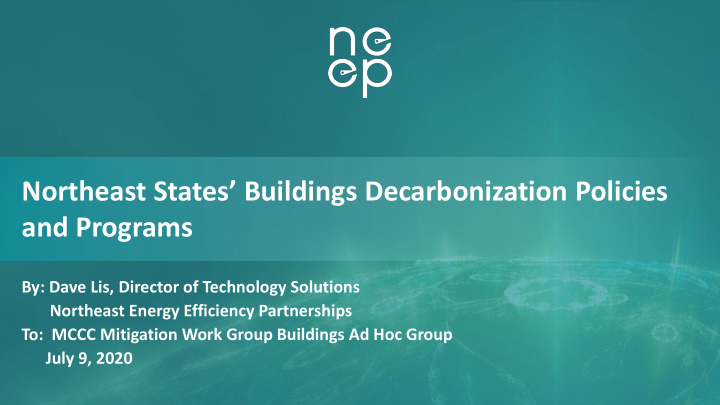



Northeast States’ Buildings Decarbonization Policies and Programs By: Dave Lis, Director of Technology Solutions Northeast Energy Efficiency Partnerships To: MCCC Mitigation Work Group Buildings Ad Hoc Group July 9, 2020
Northeast Energy Efficiency Partnerships Mission We seek to accelerate regional collaboration to promote advanced energy efficiency and related solutions in homes, buildings, industry, and communities. Approach Drive market transformation regionally by fostering collaboration and innovation, developing tools, and disseminating knowledge
Northeast Region’s Aggressive Carbon Emission Reduction Targets 2030 Carbon Reductions Goals 2050 Carbon Reductions Goals Carbon Free Cities by 2050 Aggressive 2030 Goals • New York City State of Vermont By 2028 - 50% • Washington D.C. New York City • Boston, MA By 2030 – 30% citywide from 1990 levels, large buildings • Cambridge, MA 40% from 2005 levels • Somerville, MA Washington D.C. By 2032 50% below 2006 100% Renewable by levels, ENERGY STAR building 2050 status required by 2026 For example: Burlington, VT • Concord, NH By 2025 - 10% from 2010 levels • Reading, PA Montpelier, VT • New Brunswick, By 2030 – 80% NJ And many more... 0% <65% 75% 80% 100% 0% <30% <45% 50% 2 2
Background in Building Decarbonization 3
Aren’t we on the path to 80% CO2 reductions? ~ half of the needed Historical reduction With ↑ EE/RE BAU 2001 80% Reduction 4
Aren’t we on the path to 80% CO2 reductions? ~ half of the needed Historical reduction With ↑ EE/RE BAU Where are all these 2001 “other” emissions coming from? 80% Reduction 5
Direct Use of Fossil Fuels (NE/NY) 6
Advanced Electrification Technologies 7
Pathways to Deep Decarbonization 8
Building Decarbonization 3 Key Elements Advanced Deep Energy Grid Electric Efficiency Integration Technologies Space/Water Flexible use of Thermal Heating – Heat Pumps Improvements Low-Carbon Electricity Northeast Strategic Electrification Action Plan – NEEP 2018 9
Heating Electrification Technologies Technologies • Air-Source Heat Pumps • Ground-Source Heat Pumps • Solar Thermal
University & College Campus Projects Clark University Alumni Center • 35,000 sf building (Event Spaces & Offices) • 100% heated and cooled by Air-Source VRF • Advanced controls optimize energy savings Cornell Tech Dormitory • 710,000 sf building • 100% heated and cooled by Air-Source VRF • 27 City Multi HP/HR units • Worlds tallest passive house 11
ASHP Market Size and Trends • ~100k ASHPs sold in the New York (61k)/New England (36k) region in 2017 – ~50k ASHPs sold in the same region in 2013 – ~20% Annual growth over four years • Still significantly smaller than regional furnace (235k)/boiler(160k)/Central AC (220k) markets 12
Alternative Building Decarbonization pathways • Decarbonizing Fuels vs. Electrification – Heating Oil -> Renewable Oil • Biodiesel, ethanol, synthetic fuels – Fossil Natural Gas ->Renewable Gas • Landfill gas, anaerobic digesters, gasification, synthetic gas – Hydrogen • Electrolysis • Issues of readiness, cost, scalability 13
Building Decarb Policy and Program Survey • Carbon neutral targets via legislation (currently via policy) • Heat pump adoption Targets/Goals • Promotional Programs for EE and heat pumps – Expanding EE program metrics making that easier in cases of fuel switching • Alternative Portfolio Standards • Benchmarking and Labeling • Existing Building Standards • Building Codes & Appliance Standards • Lead-by-Example • Workforce Development • Supporting communities 14
Building Decarbonization Roadmapping activities • Rhode Island – Heating Sector Transformation • Maine – Beneficial Electrification Study • Massachusetts – Decarbonization Roadmap (“80x50 Study”) • New York- – Carbon Neutral Buildings Roadmap/Building Electrification Roadmap 15
Parting thoughts Heating electrification technologies offer “here and now” solution for building decarbonization Technologies are relatively mature and industry is prepared for growth Market demand exists today and is growing Continued need for state or utility support in order to scale industries in line with state ambitions Industry stakeholders consistently identify three primary hurdles to scale industry: Upfront costs Awareness of technologies Workforce challenges (e.g. forthcoming HVAC retirements) Opportunity to bundle weatherization with heating upgrades to reduce heating system upfront costs, improve performance, and gain large savings
NEEP Resources Building Decarbonization Policies: – Building Decarbonization Public Policy Framework – Building Decarb Central – Building Energy Codes, Benchmarking & Home Energy Labels Air Source Heat Pumps: – NEEP Cold Climate ASHP Market Transformation Initiative – Air Source Heat Pump Buying Guide – Variable Refrigerant Flow (VRF) Market Strategies Report – 2019 Smart Homes & Buildings – Grid-interactive Efficient Buildings: A Tri-Regional Status Report – The Smart Energy Home: Driving Residential Building Decarbonization – 2019 Other NEEP Resources – Action Plan to Accelerate Strategic Electrification in the Northeast - 2018 17
For More Information: www.neep.org Sue Coakley, Executive Director scoakley@neep.org Dave Lis Director of Technology & Market Solutions djlis@neep.org Carolyn Sarno Goldthwaite Senior Director of Advanced Efficiency Solutions cgoldthwaite@neep.org 18
State and Local Public Policies to Accelerate Building Decarbonization Public Policy Linkages Public Health Affordable Housing Energy & Environmental Justice Climate Resiliency Economic Development State Procurement & Financing Immigration – Climate Refugees 19
Recommend
More recommend